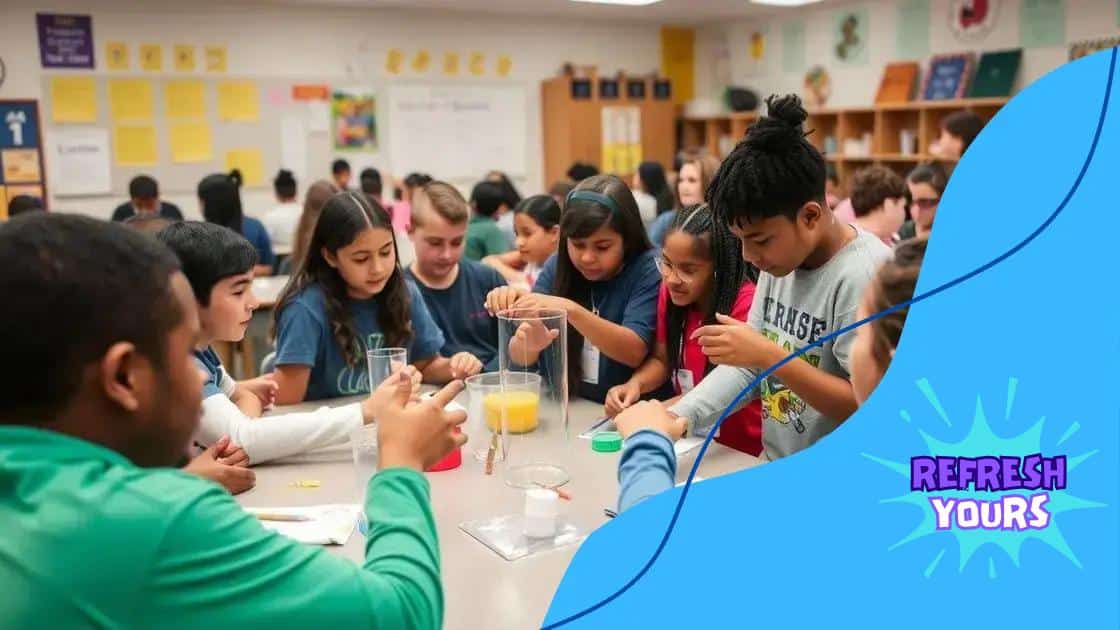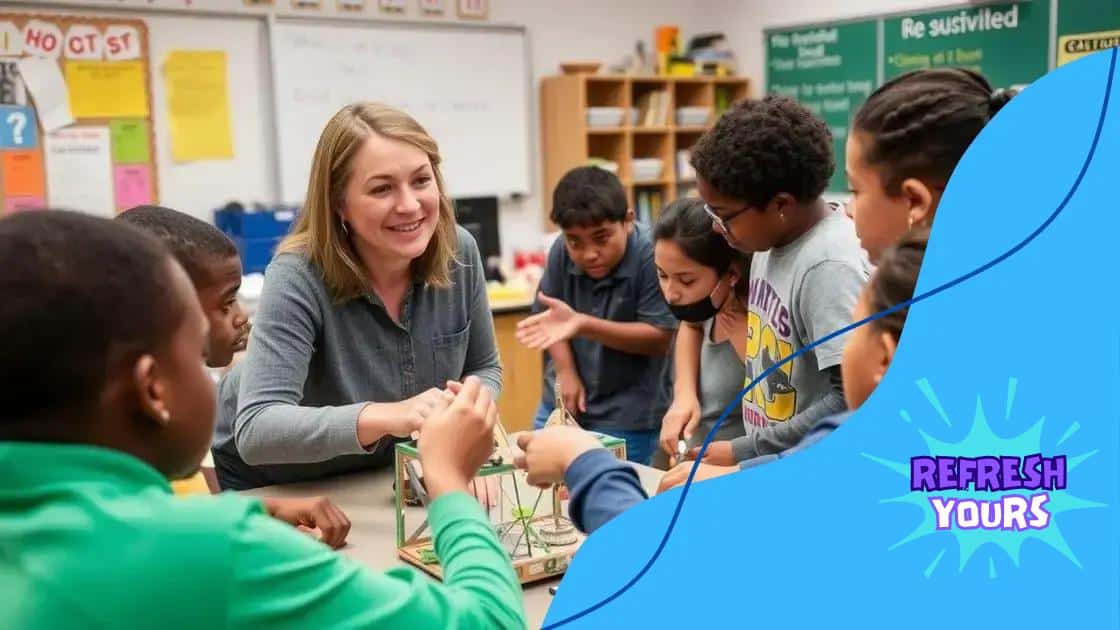The shift toward project-based learning in STEM fields

The shift toward project-based learning in STEM fields enhances student engagement and real-world skills by allowing learners to tackle practical projects that foster critical thinking and collaboration.
The shift toward project-based learning in STEM fields is more than a trend; it’s revolutionizing how students engage with science, technology, engineering, and mathematics. Have you considered how this approach might impact future generations in education?
Understanding project-based learning
Understanding project-based learning is essential for grasping how education is evolving, especially in STEM fields. This approach encourages students to learn by engaging in real-world projects, which can make learning more enjoyable and effective.
In traditional education, students often memorize facts for tests. However, with project-based learning, they get to apply what they learn in practical situations. This method helps students see the relevance of their studies, fostering a deeper understanding and retention of knowledge.
Key Components of Project-Based Learning
There are several core elements that define project-based learning. These include:
- Real-world relevance: Projects should relate to real-life problems or situations.
- Student choice: Allowing students to select projects fosters ownership and motivation.
- Collaboration: Working with peers enhances learning through teamwork.
- Reflection: Students should evaluate their experiences and what they learned.
In project-based learning, students work on projects that can last from a few days to several weeks. They not only gain knowledge in their subject area but also develop vital skills such as critical thinking and problem-solving. For example, a project might involve building a model of a sustainable city, requiring research in environmental science, design, and engineering.
This dynamic approach encourages active engagement. Instead of passively receiving information, students immerse themselves in the subject matter. For instance, while creating a robot for a competition, they learn coding, electronics, and the scientific method. Such experiences make education memorable and impactful.
Overall, project-based learning transforms the classroom into a space of exploration and discovery. As students tackle projects, they gain practical knowledge, preparing them for future careers in STEM. Understanding this approach is crucial for educators looking to inspire and motivate their students.
Benefits of project-based learning in STEM
The benefits of project-based learning in STEM education are numerous and impactful. This approach not only engages students but also facilitates deep understanding and retention of knowledge.
One of the significant advantages is that students learn to apply their skills in practical scenarios. They grasp complex concepts better when they can see how they work in real life. For instance, when building a bridge in a physics project, students explore the principles of force and tension in a hands-on manner.
Enhanced Engagement
Project-based learning captures students’ interest and motivates them. They are actively involved in their learning process, which leads to higher engagement levels. Projects also allow for creativity and exploration, making learning fun and exciting.
- Increased motivation: When students choose topics that interest them, they are more likely to stay committed.
- Collaborative skills: Working in teams helps students learn how to communicate and collaborate effectively.
- Ownership of learning: Students take responsibility for their projects, boosting their confidence.
Another benefit is the development of crucial skills necessary for future careers. As students navigate through projects, they encounter challenges that require critical thinking and problem-solving. For example, while creating a data-based project about weather patterns, they learn to analyze and interpret data.
Furthermore, project-based learning helps students build resilience. They learn that failure is part of the learning process when things don’t go as planned. This mindset fosters a growth attitude, encouraging them to try again and improve.
In summary, the approach nurtures a love for learning while equipping students with essential skills for their futures. The blend of excitement, practical application, and collaborative opportunities makes project-based learning a valuable educational method in STEM.
Challenges educators face with project-based learning

Challenges educators face with project-based learning can be significant, but understanding them is crucial for successful implementation. Teaching with this method can be rewarding, yet it requires careful planning and management.
One of the main challenges is time management. Projects can take longer than traditional lesson planning, which can disrupt the classroom schedule. Teachers must ensure that projects are well-structured and fit within the timeframe without sacrificing valuable content.
Resource Limitations
Project-based learning often demands more resources than typical methods. Schools need adequate materials and tools for students to engage in hands-on projects. This can be a hurdle for educators who might not have easy access to various resources or funding.
- Limited funding: Many schools operate on tight budgets, making it difficult to acquire necessary supplies.
- Access to technology: In a tech-driven world, lack of access to computers or software can hinder project success.
- Workspace constraints: Not all classrooms are designed for collaborative, active projects, limiting student engagement.
Another challenge educators often face is the need for training. Teachers may not feel adequately prepared to facilitate project-based learning. Professional development is essential to equip them with the skills needed to guide students effectively.
Moreover, assessing students can also be complex in this learning model. Traditional testing may not accurately reflect students’ understanding and skills gained through projects. Educators must find innovative ways to evaluate performance, such as using rubrics or peer assessments that focus on both the process and the final product.
Despite these challenges, many educators embrace project-based learning for its potential to foster engagement and deep learning. By addressing these hurdles, teachers can create a more effective learning environment where students thrive.
Strategies for implementing project-based learning
Implementing project-based learning successfully requires strategic planning. Educators can adopt several effective methods to make this approach work in their classrooms.
One key strategy is to start small. Teachers should begin with a short-term project that targets a specific learning goal. This allows both educators and students to understand the framework without feeling overwhelmed. For example, a simple science experiment can evolve into a larger exploration of environmental issues.
Effective Planning
Planning is crucial when incorporating project-based learning. Teachers need to define clear objectives and outcomes. Using backward design can help outline the steps needed for successful completion. By starting with the end goal in mind, teachers can create a roadmap that guides students through the learning process.
- Collaborative Learning: Encourage students to work in teams, promoting communication and collaboration.
- Integration of Subjects: Combine different subjects in one project to provide a holistic learning experience.
- Real-World Connections: Choose topics that relate to real-life issues, making learning relevant and engaging.
Another effective strategy is to incorporate technology. Digital tools can enhance project-based learning by providing resources for research, collaboration, and presentation. Students can use platforms like Google Slides or Padlet to create and share their work with peers.
Continuous reflection is also important. Encourage students to think about what they have learned throughout the project. Asking questions about their experiences can deepen their understanding and improve future projects. For instance, students might discuss what challenges they faced and how they overcame them.
Lastly, seeking feedback from peers and mentors can significantly enhance the learning process. Constructive criticism helps students refine their projects while learning to appreciate diverse perspectives. Implementing these strategies can cultivate a successful project-based learning environment where students thrive.
Real-world examples of project-based learning success
Real-world examples of project-based learning success can inspire educators and students alike. These examples highlight how this teaching method enhances engagement, understanding, and practical skills.
One powerful example comes from a high school in California where students undertook a project to design and implement a community garden. Not only did they learn about biology and ecology, but they also developed skills in teamwork, budgeting, and planning. The garden became a resource for the local community, demonstrating the practical benefits of their educational experience.
STEM in Action
Another noteworthy instance is in a middle school where students worked on creating a wind turbine. They researched renewable energy sources and built their turbine from materials they sourced. As a result, they learned about physics, engineering, and environmental science while actively participating in a project that had real-world implications.
- Hands-on learning: Students engaged directly with materials, fostering better understanding.
- Community impact: Projects often address local issues, making learning relevant.
- Skill development: Students gained practical skills such as problem-solving and critical thinking.
In another scenario, a group of students from a city in Australia developed a mobile app to help local residents find recycling centers. They conducted surveys to gather data and worked together to analyze the information. Through this process, they learned about computer programming, data analysis, and the importance of sustainability.
These real-world projects show how project-based learning can deeply engage students. By working on tangible projects, they not only learn academic content but also develop a sense of responsibility and community awareness. Success in these examples illustrates the potential of project-based learning to transform educational experiences.
In conclusion, project-based learning offers a dynamic and engaging way for students to understand concepts in STEM fields. By working on real-world projects, students not only gain valuable knowledge but also develop critical skills like teamwork, problem-solving, and creativity. Educators face challenges when implementing this approach, but the success stories demonstrate that with planning and support, student outcomes can improve significantly. Embracing project-based learning can transform classrooms into active, collaborative environments where students thrive.
FAQ – Frequently Asked Questions about Project-Based Learning in STEM
What is project-based learning?
Project-based learning is an educational approach where students engage in real-world projects to gain knowledge and skills through hands-on activities.
What are the benefits of project-based learning in STEM?
Benefits include increased student engagement, development of critical skills like teamwork and problem-solving, and a deeper understanding of complex concepts.
What challenges do educators face with project-based learning?
Some challenges include time management, resource limitations, and the need for professional development to effectively guide students.
Can you provide examples of successful project-based learning?
Yes! Examples include students creating community gardens, building wind turbines, or developing apps to solve local issues, all of which enhance learning and community engagement.





